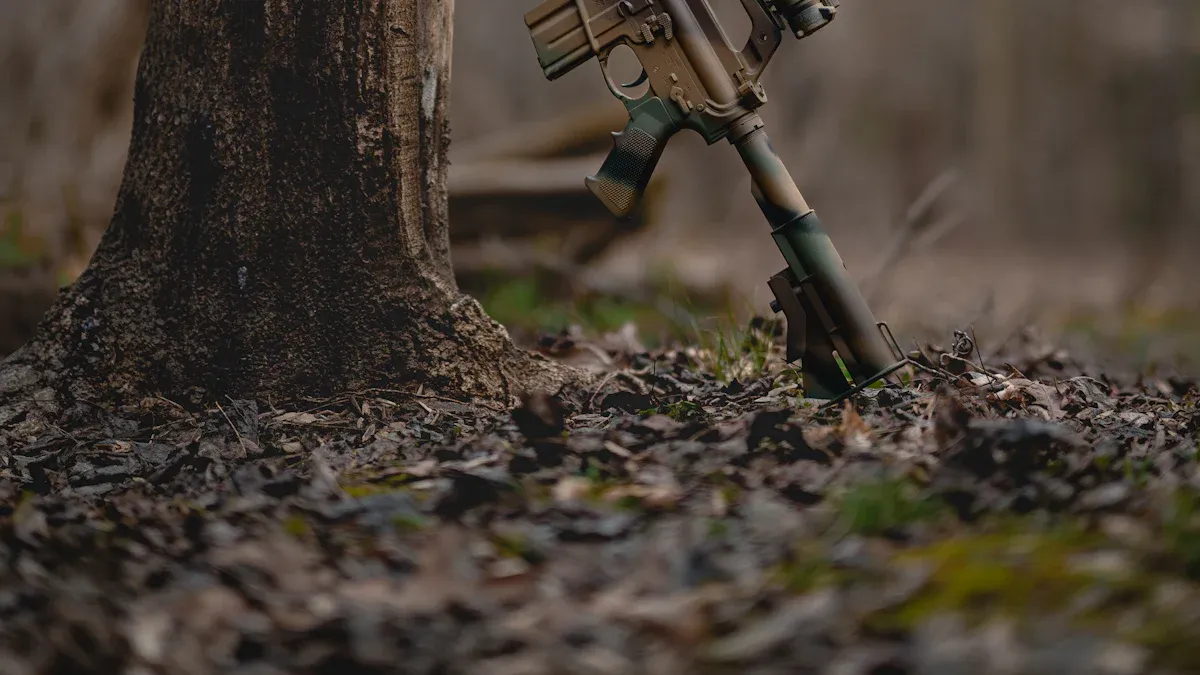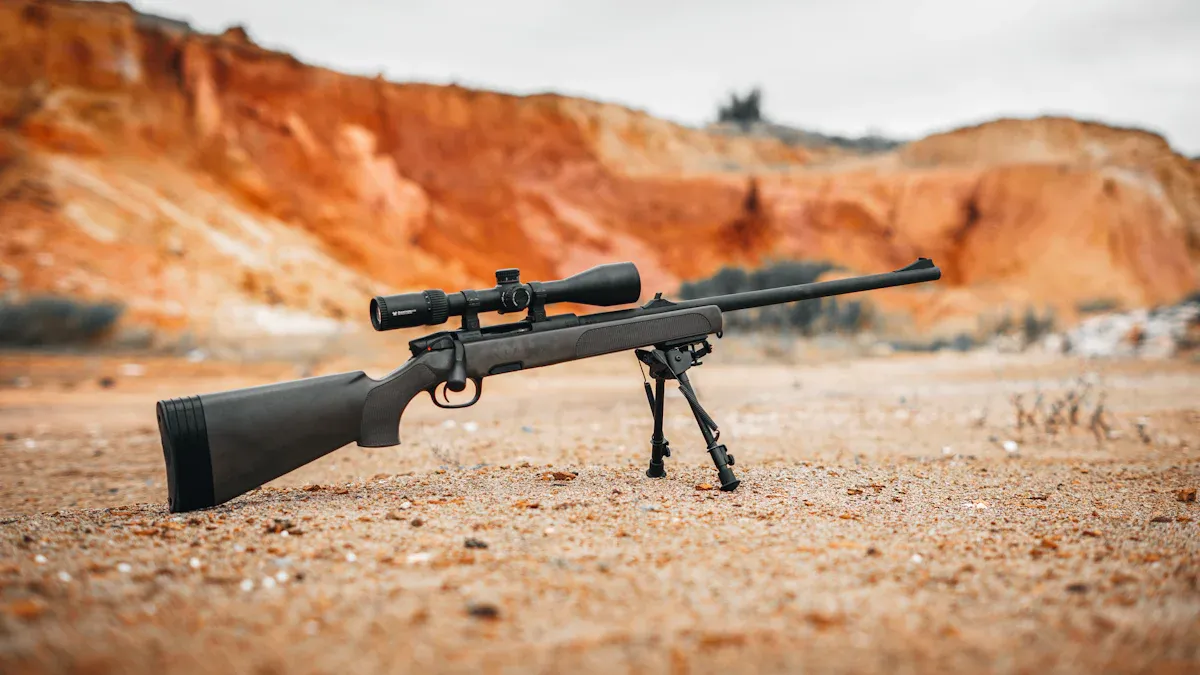A rifle bipod enhances shooting accuracy by providing stability during long-range shots. Its popularity has surged, with 65% of top shooters now carrying multiple bipods for competitions. Adjustable models, like those with ±15-degree cant, dominate the market. Features such as a secure mount, compatibility with accessories, and rail adaptability make them indispensable. Additionally, pairing a rifle scope with a quality rifle bipod can significantly improve your shooting experience.
Key Takeaways
- Pick a strong and long-lasting bipod to improve aim. Use materials like aluminum or steel that won’t bend or break.
- Look for adjustable features like separate leg movement and height options. These help you set up better on rough ground.
- Buy a good bipod that fits how you shoot. Make sure it works with your rifle and is easy to use for a better shooting time.
Key Considerations When Choosing a Rifle Bipod
Stability and Durability
A stable rifle bipod ensures consistent accuracy, even in challenging conditions. Models with thicker legs and durable materials like aluminum or steel offer better resistance to bending or breaking. Military-grade bipods often undergo rigorous tests, such as salt spray exposure for over 500 hours, to ensure corrosion resistance. For shooters in extreme environments, durability under temperatures ranging from -40°F to 160°F is essential. Atlas bipods, for instance, are known for their ability to handle heavy loads, making them a reliable choice for precision shooting.
Adjustability and Range of Motion
Adjustability enhances versatility. Look for bipods with independent leg adjustments for uneven terrain. Features like canting (up to 170°) and panning (360°) allow for precise positioning. Height adjustability is another critical factor. For example, bipods with ranges from 6 to 30 inches accommodate various shooting positions, from prone to kneeling. The MDT Ckye-Pod excels in this area, offering extensive height options for diverse scenarios.
Weight and Portability
Lightweight bipods improve portability without sacrificing stability. Models under 1.2 pounds are preferred by 78% of NATO Special Operations Forces. Carbon-fiber designs, like those used by the British Army, reduce weight by 22% compared to traditional models. For hunters, compact options like the Javelin bipod, which fits in a pocket, are ideal.
Material and Build Quality
High-quality materials ensure longevity. Bipods made from 7075-T6 aluminum or high-grade steel alloys balance strength and weight efficiency. These materials withstand rugged conditions, making them suitable for tactical and hunting applications. Additionally, non-slip rubber feet or spiked legs enhance grip on various surfaces.
Price and Value for Money
Investing in a premium rifle bipod often pays off in performance. While budget options under $150 may appeal to beginners, premium models above $249 offer superior features and durability. The global market for tactical bipods is growing, with a projected value of $444 million by 2030, reflecting their increasing demand among serious shooters.
Compatibility with Rifles and Shooting Styles
A good bipod must match your rifle and shooting technique. Ensure compatibility with attachment points like Picatinny rails or M-LOK systems. Fixed bipods provide stability, while pivoting models offer flexibility for tracking moving targets. Adjustable legs and quick-deploy features enhance adaptability, making them suitable for both hunting and competitive shooting.
Detailed Reviews of Top Rifle Bipods

MDT Ckye-Pod Gen2 – Features, Pros, Cons, and Price
The MDT Ckye-Pod Gen2 stands out as a premium option for precision shooters. Its construction includes spiked feet, which are compatible with Atlas bipod feet, ensuring versatility. The adjustable leg spread offers three positions—narrow, middle, and wide—allowing users to adapt to various shooting scenarios. With a 170-degree cant and a tool-less tension adjustment knob, it provides exceptional flexibility. The solid locking pan feature enables 360-degree panning, making it ideal for dynamic shooting environments.
Shooters appreciate the ease of use, as the legs extend without requiring button presses and can be adjusted while in position. This bipod excels in National Rifle League (NRL) and Precision Rifle Series (PRS) competitions due to its adaptability. Priced at $600, it represents a significant investment but delivers unmatched performance for serious enthusiasts.
| Feature | Description |
|---|---|
| Construction | Ships with spiked feet, compatible with Atlas bipod feet. |
| Leg Adjustments | Adjustable leg spread angle with three positions (narrow, middle, wide). |
| Cant Feature | Offers 170 degrees of cant with a tool-less tension adjustment knob. |
| Pan Feature | Solid locking pan feature allowing full 360-degree panning when disengaged. |
| Usability | Easy leg extension without pressing a button; can be adjusted while in shooting position. |
| Versatility | Highly adaptable for various shooting scenarios, making it suitable for NRL/PRS-style shooting. |
| Price | Priced at $600, considered a worthwhile investment for its features and performance. |
Magpul MOE Bipod – Features, Pros, Cons, and Price
The Magpul MOE Bipod is a budget-friendly option that balances affordability and functionality. Its simple design includes independently adjustable legs, allowing for versatile use. The bipod offers a tilt of 50° and a pan of 40°, enhancing target engagement. Adjustable leg extensions lock securely with a button, providing heights between 6.8″ and 10.3″.
Made from durable materials like steel and Mil-Spec hard anodized aluminum, it withstands rugged conditions. Field tests reveal excellent performance in various scenarios, from bench shooting to prone positions. Rubber feet ensure a stable grip on different surfaces, while adjustments for aim are straightforward. Priced under $150, it is an excellent choice for beginners or those seeking a reliable, cost-effective rifle bipod.
- Key Features:
- Easy leg deployment and adjustable height.
- Independent leg adjustments for uneven terrain.
- Durable construction with steel and aluminum materials.
- Tilt and pan capabilities for enhanced versatility.
- Pros:
- Affordable and user-friendly.
- Lightweight yet durable.
- Cons:
- Limited advanced features compared to premium models.
In field tests, users praised its stability and ease of use, making it a dependable option for casual shooters and hunters alike.
Comparison Table of Top Rifle Bipods

Key Features Compared
When choosing a rifle bipod, understanding the key features of each model can simplify the decision-making process. The table below highlights the weight, height range, and notable pros and cons of some top options:
| Bipod Model | Weight (oz) | Height (inches) | Pros/Cons |
|---|---|---|---|
| Magpul Bipod | N/A | N/A | Affordable, Lightweight, Low Profile; Not suitable for heavy recoiling rifles |
| Atlas Bipods 5-H | 25.74 | 6.62 to 10.5 | Extremely Strong, Superbly Stable, Versatile Height; Hefty |
| Caldwell Accumax Premium | 11.76 | 13 to 30 | Lightweight, Good for hunting; Less suited for heavy-duty precision rifles |
The Atlas Bipods 5-H stands out for its strength and stability, making it ideal for precision shooting. On the other hand, the Caldwell Accumax Premium offers excellent portability and height adjustability, which appeals to hunters. The Magpul Bipod provides an affordable and lightweight option, though it may not handle heavy recoil effectively.
Price Points and Value
Price plays a significant role in selecting the right rifle bipod. Premium models like the Atlas Bipods 5-H justify their higher price with unmatched durability and performance. For shooters seeking a balance between cost and functionality, the Caldwell Accumax Premium offers great value, especially for hunting applications. Budget-conscious buyers may find the Magpul Bipod appealing due to its affordability and reliable performance for casual use.
Investing in a high-quality rifle bipod ensures long-term reliability and improved shooting accuracy. While premium options may require a larger upfront investment, their durability and advanced features often make them a cost-effective choice over time.
How to Choose the Right Bipod for Your Needs
For Long-Range Precision Shooting
Precision shooters require a bipod that delivers stability and adaptability. Models like the Accu-Tac FC-5 G2 excel in this category, offering unmatched stability for F-Class competitions. Features such as adjustable leg height and a wide stance ensure accuracy over long distances. The Atlas Bipod, favored by 38% of top shooters, provides quick deployment and durable construction, making it a reliable choice for precision shooting. A lightweight design, combined with robust materials, ensures the rifle remains steady without adding unnecessary weight.
For Hunting and Field Use
Hunters need a bipod that is lightweight, portable, and easy to deploy. The Caldwell XLA Pivot, priced around $50, is a popular choice for its compact design and multiple leg configurations. Quick-deploy features allow hunters to set up in under two seconds, ensuring they never miss a shot. Durable materials like aluminum or polymer ensure the bipod withstands rugged outdoor conditions. Additionally, models with rubber feet or spiked legs provide stability on uneven terrain, making them ideal for field use.
For Budget-Conscious Buyers
Affordable options like the Magpul MOE Bipod cater to budget-conscious buyers without compromising on essential features. Priced under $150, it offers adjustable legs and durable construction, making it a practical choice for casual shooters. The tactical rifle bipod market shows a clear segmentation, with lower-tier models priced between $79 and $129. These options provide value for money, though they may lack the advanced features of premium models.
For Competitive Shooters
Competitive shooters benefit from bipods designed for quick adjustments and portability. Models like the Atlas PSR, starting at $260, offer customizable features and a lightweight design. Quick deployment in under two seconds allows shooters to adapt to various angles efficiently. Spring-loaded mechanisms and durable materials ensure reliability during high-pressure matches. These features make competitive shooting more manageable, allowing participants to focus on precision and performance.
Choosing the right rifle bipod depends on your shooting style, environment, and budget. Lightweight models suit hunters, while heavier options provide stability for precision shooting. Investing in reputable brands ensures durability and performance. Features like quick-deploy legs and adjustable heights enhance usability. The table below highlights key factors to consider:
| Factor | Description |
|---|---|
| Weight | Affects portability; lightweight for hunting, heavier for stability in precision shooting. |
| Price | Quality varies; investing in reputable brands often leads to better durability and performance. |
| User-Friendliness | Features like quick-deploy legs enhance ease of use in fast-paced situations. |
| Reviews and Recommendations | Insights from experienced shooters can guide choices based on performance and reliability. |
| Brand Reputation | Established brands typically have a history of producing quality products. |
Assess your needs carefully to find the perfect bipod for your rifle and shooting goals.
FAQ
What is the ideal height range for a rifle bipod?
The ideal height depends on the shooting position. For prone shooting, 6-9 inches works best. Taller bipods (up to 30 inches) suit kneeling or uneven terrain.
Can a single bipod work for all shooting styles?
No, different styles require specific features. Precision shooting needs stability, while hunting demands portability. Choose a bipod tailored to your primary shooting activity.
How do I ensure my bipod is compatible with my rifle?
Check the attachment system. Most bipods fit Picatinny or M-LOK rails. Verify your rifle’s mounting system before purchasing to avoid compatibility issues.
Post time: Mar-31-2025
